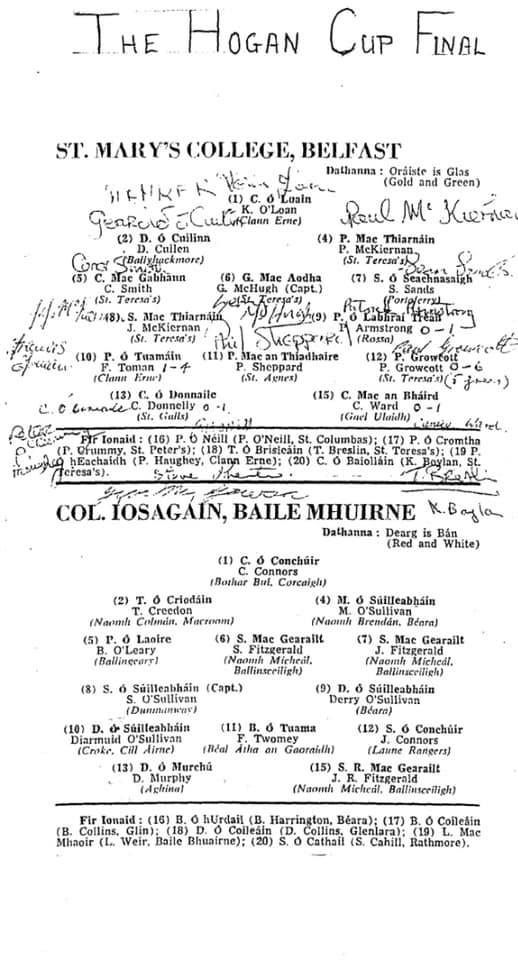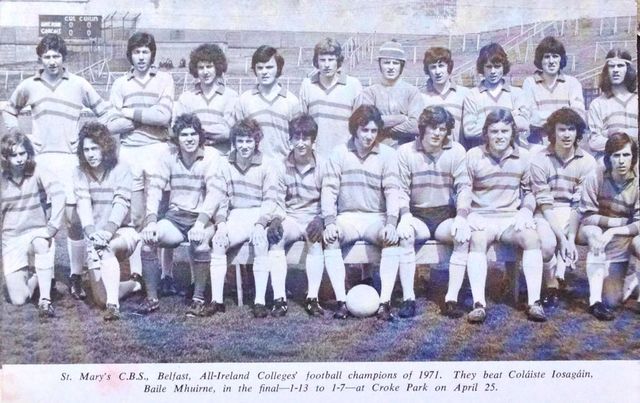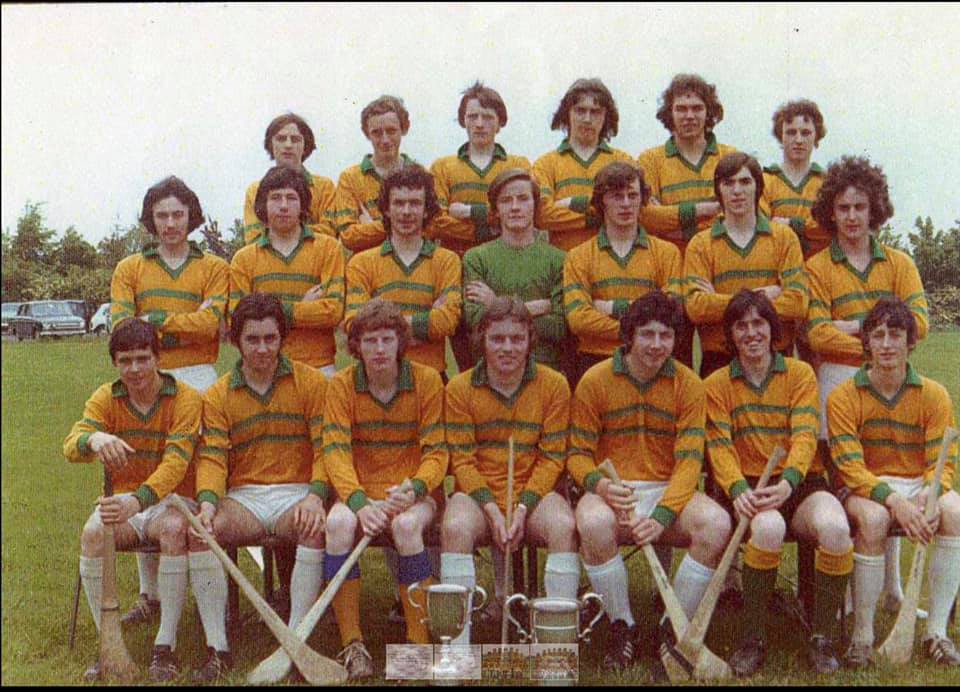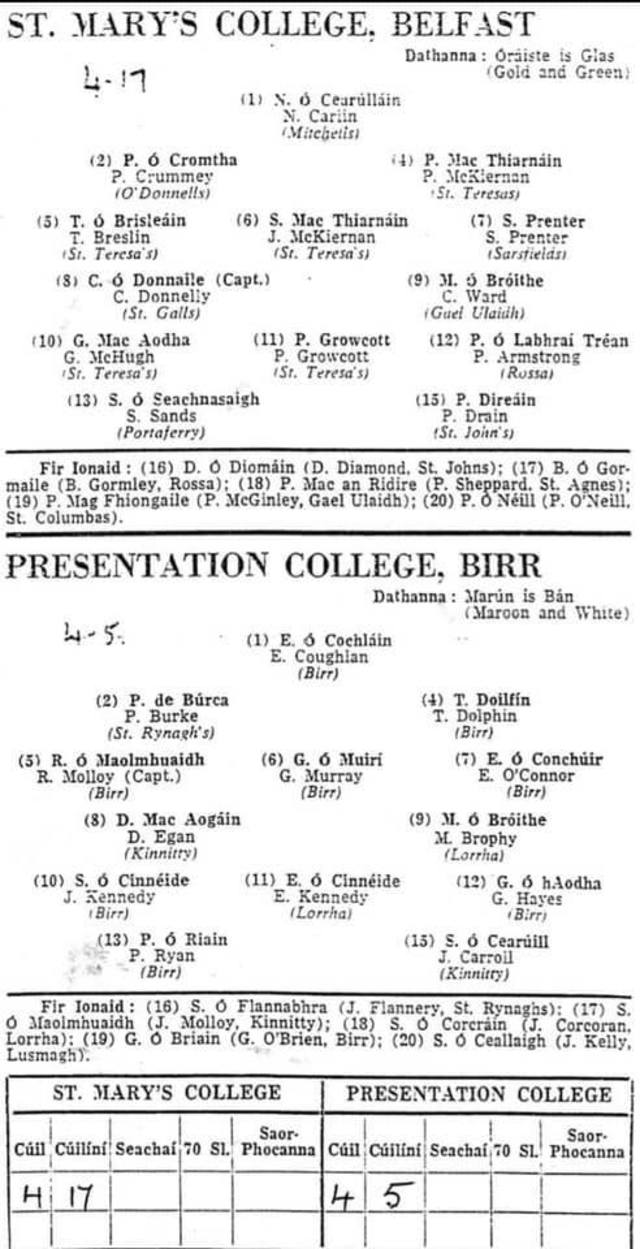Sporting success is no stranger to St Mary’s CBGS, but this week it will look back 50 years on a seven-day period when they completed a unique double
A GOLDEN generation and golden memories. That is what a special group of hurlers and footballers from the 1971 St Mary’s CBGS teams will reflect upon this week as they mark 50 years since making a unique piece of history, when winning a Colleges All-Ireland double.
The Glen Road institution is no stranger to success with the small ball. Undisputed kings of Ulster Colleges hurling, the class of ‘71 would claim one of the school’s 28 Mageean Cup titles, but this was just the tip of the iceberg as All-Ireland B glory would follow for the first time that year.
MacRory Cup success has not been so plentiful with the trophy visiting the school on just two occasions. The first was in ‘71, but like the hurlers, the school’s footballers would go onto reach even greater heights as they were crowned All-Ireland champions by securing the Hogan Cup.
No fewer than nine players would enjoy a week for the ages as they triumphed on the Croke Park sod on successive Sundays and to mark this remarkable achievement, a reunion is due to be held later in the year for those Simmarians who scaled the highest of highs.
One member of both teams, Pat ‘Bap’ Armstrong, looks back on those days with fondness, saying: “To think it’s 50 years ago... where has the time gone?”
********
Antrim schools have not enjoyed huge success in Ulster Colleges’ blue riband football competition and that was the case as the 1970s dawned, but the county appeared on the up.
The summer of ‘69 saw the Saffrons’ U21s claim All-Ireland glory and the following year the seniors would reach the Ulster final, only to be beaten by Derry.
There was cause for optimism as a St Malachy’s College team would claim their second MacRory Cup and go onto the All-Ireland final, coached by Phil Stuart who ironically had earlier helped hone the skills of four players in his past role at Holy Child PS who would contribute to his own team’s demise the following year: Paul Growcott, Phillip Sheppard, Tom Breslin and team captain, Gerry McHugh.

“The county was generally strong at that time,” said Armstrong, regarded as one of the best footballers in Ulster during his career with Rossa and Antrim.
“They won the All-Ireland U21 in 1969, then in ‘74 we were beaten in the final after a replay by Mayo; in ‘75 they won Ulster again and the basis of a very good Kerry side beat them in the All-Ireland semi-final.”
St Malachy’s would enter the 1971 year as strong contenders to retain the MacRory Cup, but across town, a St Mary’s CBGS team coached by ‘The Boot’, Brother Nolan, would be plotting their own uprising.
The lads from the Glen Road opened their campaign with an impressive victory in the group stage against St Coleman’s, Newry, before taking down Garron Tower in their second game.
Knowing what we know now about their glorious history in the competition this may seem rather odd, but in 1971 St Patrick’s College, Maghera, was relatively new on the scene having first opened its doors in 1963 and viewed as a routine win for the more established schools at the time.
Such thinking almost cost St Mary’s dearly as they just about squeezed home by the minimum, but they would sound warning in their following game with an impressive victory over 1965 winners, St Columb’s from Derry.
The year would prove to be a landmark one, as at the GAA’s annual congress on the weekend of April 10/11 held at Queen’s University’s Whitla Hall, the controversial Rule 27, better known as ‘The Ban’, prohibiting members from playing what were deemed as ‘foreign sports’ was overturned.
Just two counties, Antrim and Sligo, voted to uphold the rule and perhaps that thinking was to see the eagerly-anticipated MacRory Cup semi-final between St Mary’s and the defending champions moved away from Casement Park at the behest of the Antrim County Board due to a certain St Malachy’s star who also played soccer.
“Martin O’Neill was playing for Distillery then,” Pat recalls.
“The thing was that colleges’ students weren’t affected by The Ban, but it was the County Board who wouldn’t let us play there. It was actually the year that The Ban was lifted over at Queen’s, but our County Board was one of a couple that had voted to keep it.”
St Mary's team before the Hogan Cup final
Instead, the game on February 21 was moved to the grounds of Omagh CBS with St Mary’s romping to a handsome 4-9 to 1-8 victory.
A first MacRory Cup was now in view for the Glen Road lads and they duly delivered with a 1-11 to 1-7 win over Newry’s Abbey CBS in Lurgan.
With the wind in their sails, St Mary’s defeated St Mel’s from Longford in the All-Ireland semi-final.
Aided by goals from Paul Growcott and Canice Ward, the 2-6 to 0-4 victory over the Leinster champions set-up a Hogan Cup final showdown against Munster champions, Coláiste Iosagáin, Ballyvourney, on Sunday, April 25 at Croke Park.
St Mary’s led by 0-7 to 0-4 at half time, despite playing against a tricky wind, but their Cork opponents did have a little misfortune as they hit the post on three occasions in the opening 10 minutes.
Kevin O’Loan made a great save early in the second period to keep St Mary’s on top and Paul Growcott and Lurgan native Frank Toman, in particular, were dominant attack, scoring 1-10 between them. The latter was creating his own history as this would be his second winners medal having won four years earlier as a 15-year-old with St Coleman’s, Newry.
A missed penalty in the 23rd minute by Iosagáin sealed their fate as St Mary’s winning out 1-13 to 1-7 winners to be crowned All-Ireland champions as captain, Gerry McHugh hoisted the Hogan Cup in the Hogan Stand.
It remains the greatest football triumph in the history of the school and indeed, it would take until 1986 before St Mary’s would win their second, and only other, MacRory Cup.
“We could have won the Hogan again the next year, but we were very unlucky,” Armstrong suggests. “We beat St Pat’s, Cavan, in our section of the MacRory, topped our group unbeaten, and then played St Columb’s, Derry, but we were missing two key players and were narrowly beaten.
“St Pat’s, Cavan, then went onto win the MacRory and Hogan that year, and we were the only team to beat them.”
Still, that day in Croke Park is one that will never be forgotten and as it turns out, not only in Belfast as Pat’s connection with that Coláiste Iosagáin team was not quite over.
A twist of fate and a family connection would bring it all back again in later years: “My brother-in-law’s wife is from Valencia (Kerry) and her brother was the manager of the team we beat in the final.
“A lot of years later, he came up to visit once and said to my wife: ‘the only two Armstrongs I know are Kevin - who was my father - and Pat Armstrong who played midfield for St Mary’s against the team I was managing in the Hogan Cup final.’
“Well, she said: ‘that’s my husband and where you’re staying for the next couple of nights.’ Small world.”
Whilst the St Mary’s team, led by panellist and guitarist Peter Crummey, celebrated their success on that April evening, they were far from finished for the year as seven days later, there was another appointment back at GAA headquarters...
********
There were some parallels between both codes as far as Antrim had gone in this era, as in 1970, led by a Cork man named Justin McCarthy, the Saffrons would claim All-Ireland Intermediate honours.
The hurling team that claimed the O'Keefe Cup 
They do say success breeds success and while St Mary’s would wrack up the provincial titles, success on a national scale would elude them.
A heavy semi-final defeat to St Peter’s, Wexford, in 1967 prompted a drop down to the ‘B’ division but it would be a few years before they reached their goal, albeit with a slice of fortune.
Beaten by Garron Tower in what was a league system early in the Ulster competition, it appeared the Mageean title was gone but the North Antrim school’s shock loss to ‘Red High’ from Downpatrick would offer a reprieve as St Mary’s, led by Brother McGreevy, made no mistake in the final against the Tower.
An All-Ireland semi-final victory over the Connacht champions would result in a return to Croke Park just seven days after the football success to face Presentation College, Birr, for the O’Keefe Cup.
Nine of the victorious football team, including Pat Armstrong, would form part of the panel but his Rossa club-mate Brian Gormley has opted to put all his energies into the hurling team that year and was therefore determined to claim his own All-Ireland success.
“At the start of the year I was on the football panel, training with Brother Nolan and the lads,” recalls Brian, who now resides in Galway.
“I don’t know if I’d have made the team but I thought I would just concentrate on the hurling, not knowing they would end up winning the Hogan Cup!
“But that group of hurlers were fairly successful through the years and won Ulster at each age group.
“When it came to the senior level, even though it was a secondary competition, it was still an All-Ireland competition so quite an achievement.”
On Sunday, May 2, the St Mary’s lads took to the sacred sod for the first of a triple-header that would also see Antrim claim Vocational Schools honours at the expense of Tipperary North.
Their Offaly opponents would contain some soon-to-be household names including Eugene Coughlan who would go onto claim the MacCarthy Cup twice with the Faithful County in the 1980s.
However, St Mary’s had stars of their own and with John McKiernan linking-up from the Hogan Cup side.
They would play some excellent ground hurling and had established a 0-10 to 0-4 lead approaching the break, but two late goals from the Birr college left the sides level at half-time.
This would not prove to be a fatal setback, as St Mary’s simply upped their game to dominate the second period.
One of the dual stars, Paul Growcott was on fire from placed balls and open play, while Canice Ward, Sean Sands and team captain Ciaran Donnelly led the way as St Mary’s ran out 4-17 to 4-5 winners.
Back then, it was 13-a-side and Gormley was one of the luckless players who didn’t start, but he would make his mark by finding the net upon his introduction in what was a magnificent team performance.
“I was a sub and came on in the final and scored a goal. I have a memory of reading a match report that said I scored two goals, but it was just the one.”
Alongside Armstrong, Gormley would go onto enjoy major success with Rossa and represent county and province in recent years, so rightly looks back with fondness, but this would not be the only All-Ireland medal he would claim.
“I went to St Joseph’s Training College (which later amalgamated with St Mary’s on the Falls Road) and again, while it wasn’t the top colleges’ competition, I won there,” he said.
“At Rossa, it was the good old days when we won Championships and Leagues, played in an All-Ireland semi-final, so I was lucky in my hurling carer to come through when I did as there was a lot of success.”
177721308_2242037022596520_2856266634929426048_n.jpg
The glory days of 1971 were built on hard work in a school that has always had a rich culture in the promotion of Gaelic Games.
Countless top-class hurlers and footballers have graced its halls, and honed their skills on the grass pitches at the foot of Black Mountain or on the old, gravel all-weather pitch.
‘The Ban’ was long gone but the time the school fielded in soccer and back in ‘71, even playing the game on lunch break was frowned upon.
Perhaps this is a factor in the success it has had over the years, but it is one of just a few traditions from 50 years ago that have long since passed.
“One of the features of the school was a smoking room, something you wouldn’t get nowadays, but that’s where we had the team meetings,” Brian recalls with a chuckle.
“The other thing we had was the all-weather pitch - all black stones - but I remember at lunchtime a few of us used to play a bit of a soccer match with a tennis ball but Brother McGreevy - ‘The Boot’ - came storming across, grabbed the tennis ball and said there would be no foreign games played here.
“In fairness, maybe that’s why the hurling and football was so strong in the school.”
A lot changes in 50 years and old friends can drift apart.
There was a 40-year reunion for the class of ‘71, but with this being the 50th anniversary, plans are afoot to mark the occasion.
For now, the WhatsApp group will ping and Zoom call to mark the date will suffice, but already the old yarns and friendships have been brought back to life.
“Typical Irish men, we haven’t kept in touch with each other,” Brian admits.
“It was lovely to have the 40th reunion and now we have a WhatsApp set-up there by Hugh (McGettigan) so already a few of the lads have been in contact, so it will be lovely to have another reunion when we can.
“Great memories of the time with a great group of lads so I’m really looking forward to the reunion.”
Much may have changed over the years, but in St Mary’s CBGS, sporting success has always been a major source of pride for present and past pupils.
The past glories have always inspired the next generation and there is no better tale to tell than of the special group that scaled the heights and paved the way by completing an All-Ireland double in 1971.





